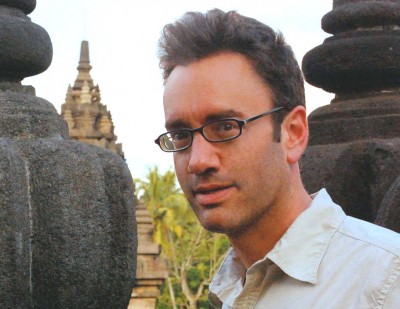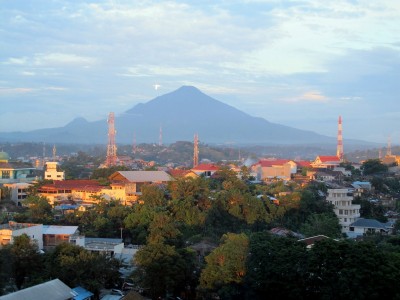New research is published in Visual Anthropology Review
TACOMA, Wash. – Christians who feel vulnerable in the face of the rising tide of popular Islam in post-Suharto Indonesia have found a way to create their own haven.
In the city of Manado, North Sulawesi, where Christianity binds a disparate ethnic population, a flourishing potpourri of local television stations has sprung up since the 1998 fall of the Suharto regime. These Christian-leaning stations, with their portrayal of Western-sympathetic politics and local community life, have created a cultural oasis for Minahasans, the majority ethnic group of the province.
A new study of this local anomaly by Gareth Barkin, media anthropologist at University of Puget Sound, Tacoma, Wash., is published in the current issue of Visual Anthropology Review. His article, “Reterritorialization in the Micromediascape: Indonesian Regional Television Amid the Rise of Normative Media-Islam,” analyses how local stations have defied the mass media trend across Indonesia and created a comfort zone for North Sulawesi’s 2.2 million people, amid rising anti-Christian violence across the 90 percent Muslim country.
“The religious tone in Indonesia has hardened noticeably in the past 15 years, and national media have reflected this with broadcasts that are fusing “Indonesianness” with Islam, sidelining religious minorities,” said Barkin. “What surprised me is not just how Minahasan Christians have used their media to create a sense of security. They also have maintained good relations with local Muslims, largely avoiding the sectarian violence that has gripped nearby provinces.”Barkin focuses on Manado’s Pacific TV, though the influence of local media, with its Christian bent, is apparent in much of North Sulawesi—a province of the Southeast Asian nation. On the nearby island of Bunaken, this cultural grasp is even more extreme. Every evening, from 6 p.m. to 11 p.m., loudspeakers serve as a sort of public radio, compelling everyone to listen to domestically produced Christian pop music and reports on locals’ donations toward the rebuilding of churches and other projects.
In seaside Manado, near the northern tip of Sulawesi, the aerial towers of five (soon to be six) regional television stations probe the skyline. The stations serve up local fare, Christian worship shows, and an unusual amount of Western-oriented programming—including interviews with visiting Western diplomats, Voice of America, and Deutsche Welle. They are surprisingly popular. In most major cities, such as Yogyakarta, national television attracts the lion’s share of audiences. These national stations are leveraging religious sentiment with content that includes Ramadan soap operas and new “reality shows” in which “families negotiate challenges through the lens of Islam,” as Barkin writes.
Pacific TV is North Sulawesi’s most popular station. Started by a local couple in 2003, it is reportedly watched by nearly as many people as Jogja TV in Yogyakarta, despite having one-fifth the population within its coverage area. This is all the more unexpected because the province’s population is disparate—made up of eight historical language groups who were designated by 19th-century Dutch colonialists to be in a region called Minahasa.
Whereas many local stations attract audiences because their programming uses regional languages such as Javanese or Balinese, “Minahasans tune in to local TV even though it’s in the same language as national broadcasts,” Barkin says. “Most Indonesians consider national television to be ‘our TV,’ whereas in North Sulawesi, it’s ‘theirs.’”
In the 15 years since General Suharto’s three-decade-long presidency collapsed, violence against Christians has risen dramatically. In 2010 a record number of anti-Christian incidents were recorded. In 2011 that number nearly doubled, accompanied by claims of government complicity or inaction in cases of Christian victimization.
Barkin conducted his field research largely over the summers of 2011 and 2012, interviewing dozens of Indonesians in North Sulawesi and Yogyakarata. He also drew on other researchers’ work and used data that he collected over the previous decade, including a 20-month field study of national broadcast culture in the city of Jakarta.
For a copy of “Reterritorialization in the Micromediascape: Indonesian Regional Television Amid the Rise of Normative Media-Islam,” visit: http://onlinelibrary.wiley.com/doi/10.1111/var.12003/abstract.
Gareth Barkin is associate professor in the Department of Sociology and Anthropology and the Asian Studies Program at University of Puget Sound, Tacoma, Wash. As a media anthropologist, he has researched the television industry in Indonesia, and how producers create models of citizenship and Muslim identity through commercial programming. His academic interests include visual and media anthropology, Southeast Asian studies, representations of Islam, global media markets, transnational culture flows, and ethnographic filmmaking. He is currently conducting research on broadcast culture in East Timor.
Press photos of Gareth Barkin and the city of Manado are available upon request.
Photos on page: Top right: Television tower in Manado; Above left: Gareth Barkin in Indonesia; Above right: Manado with its array of television towers.
Tweet this: Christians in #Indonesia. A cultural media study by Gareth Barkin @univpugetsound now in #anthropology journal http://bit.ly/1dfuLow
Follow us on Twitter! www.twitter.com/univpugetsound



